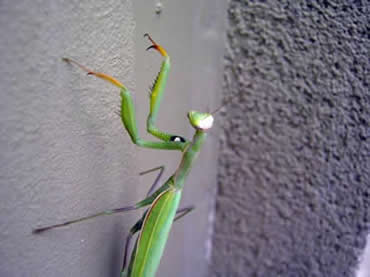

MANTIDS (MANTODEA) OF BRITISH COLUMBIA

Praying Mantis (Mantis religiosa), photo by Diane Williamson
(note diagnostic spot on foreleg)
by
R. A. Cannings and G. G. E. Scudder
Copyright © 2005 - All rights reserved
Extracted from the forthcoming publication The Insect Families of British Columbia
Introduction (draft only)
The Order Mantodea is primarily tropical, with about 1800 known species in 8 families. The two mantids living in British Columbia, one native, the other introduced, represent a single family, the Mantidae. Like the termites (Order Isoptera) , they are closely related to the cockroaches (Order Blattodea) and the three groups are sometimes classified as suborders of a single order, the Dictuoptera.
Mantids are medium to large sized insect predators of other insects, although some of the large tropical ones will capture more impressive prey such as reptiles and small birds. The prothorax is usually elongate, bearing large, grasping front legs characterized by extremely long coxae and strongly spined femora and tibiae. When waiting for prey, the insect raises these powerful legs together in front of the body, ready to strike. The highly mobile head is usually triangular with prominent, widely separated eyes; there are three ocelli. The antennae are long and thread-like; the mouthparts are chewing, with strongly toothed mandibles. Wings are often reduced or absent, especially in females, but when well developed, the forewings are rather narrow and leathery and, when at rest, cover the broadly based, membranous hindwings. Nymphs are usually similar to adults except for the lack of fully developed genitalia and wings, when present. There are 6 to 9 nymphal moults.
Litaneutria minor (Ground Mantid). Female. Haynes Lease Ecological Reserve,
north end of Osoyoos Lake, BC. Photo by Robert A. Cannings.
Most species fly strongly, but spend much time motionless, waiting for prey. Many are camouflaged, presumably mainly to deceive potential prey, and some species are superb mimics of twigs, leaves or flowers such as orchids, near which they wait in ambush. Some mantids, especially ground dwelling ones, run quickly and actively pursue prey. Most species act aggressively when alarmed. Mantids are sometimes released in attempts to control pest insects, but like most generalist predators, are too indiscriminate in their choice of prey to have much effect.
To mate, the male must approach the female without being observed, because most hungry females do not distinguish between suitors and prey. Even males successful in mating may be devoured. The female lays several to many egg masses (oothecae); the abundant eggs are arranged in rows in a frothy mass that hardens into a papery or spongy case on stems, twigs or other surfaces. In British Columbia, mantids lay eggs in the fall and the eggs overwinter.
References
Cannings, R.A. 1987. The Ground Mantis, Litaneutria minor (Dictuoptera: Mantidae), in British Columbia. Journal of the Entomological Society of British Columbia 84: 64-65.
Vickery. V.R. and D.K.McE. Kevan. 1985. The Insects and Arachnids of Canada. Part 14. The Grasshoppers, Crickets, and related Insects of Canada and Adjacent Regions. Agriculture Canada Research Branch Publication 1777. Ottawa. 918 pp.
Note:
This write up is extracted from the forthcoming publication by Scudder and Cannings: the Insect Families of British Columbia.
Illustrations by L. L. Lucas. Copyright © 2005 - All rights reserved
Please cite these pages as:
Author, date, page title. In: Klinkenberg, Brian. (Editor) 2021. E-Fauna BC: Electronic Atlas of the Fauna of British Columbia [www.efauna.bc.ca]. Lab for Advanced Spatial Analysis, Department of Geography, University of British Columbia, Vancouver. [Date Accessed]
© Copyright 2021 E-Fauna BC.